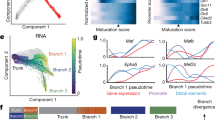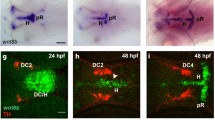Abstract
In many regions of the developing CNS, distinct cell types are born at different times. The means by which discrete and stereotyped temporal switches in cellular identities are acquired remains poorly understood. To address this, we have examined how visceral motor neurons (VMNs) and serotonergic neurons, two neuronal subtypes, are sequentially generated from a common progenitor pool in the vertebrate hindbrain. We found that the forkhead transcription factor Foxa2, acting in progenitors, is essential for the transition from VMN to serotonergic neurogenesis. Loss-of-function and gain-of-function experiments indicated that Foxa2 activates the switch through a temporal cross-repressive interaction with paired-like homeobox 2b (Phox2b), the VMN progenitor determinant. This mechanism bears a marked resemblance to the cross-repression between neighboring domains of transcription factors that establish discrete progenitor identities along the spatial axes. Moreover, the subsequent differentiation of central serotonergic neurons required both the suppression of VMN neurogenesis and the induction of downstream intrinsic determinants of serotonergic identity by Foxa2.
This is a preview of subscription content, access via your institution
Access options
Subscribe to this journal
Receive 12 print issues and online access
$209.00 per year
only $17.42 per issue
Buy this article
- Purchase on Springer Link
- Instant access to full article PDF
Prices may be subject to local taxes which are calculated during checkout




Similar content being viewed by others
References
Jessell, T.M. Neuronal specification in the spinal cord: inductive signals and transcriptional codes. Nat. Rev. Genet. 1, 20–29 (2000).
Pearson, B.J. & Doe, C.Q. Specification of temporal identity in the developing nervous system. Annu. Rev. Cell Dev. Biol. 20, 619–647 (2004).
Cordes, S.P. Molecular genetics of cranial nerve development in mouse. Nat. Rev. Neurosci. 2, 611–623 (2001).
Jacob, J., Tiveron, M.C., Brunet, J.F. & Guthrie, S. Role of the target in the pathfinding of facial visceral motor axons. Mol. Cell. Neurosci. 16, 14–26 (2000).
Jacobs, B.L. & Azmitia, E.C. Structure and function of the brain serotonin system. Physiol. Rev. 72, 165–229 (1992).
Gaspar, P., Cases, O. & Maroteaux, L. The developmental role of serotonin: news from mouse molecular genetics. Nat. Rev. Neurosci. 4, 1002–1012 (2003).
Paterson, D.S. et al. Multiple serotonergic brainstem abnormalities in sudden infant death syndrome. J. Am. Med. Assoc. 296, 2124–2132 (2006).
Pierce, E.T. Time of origin of neurons in the brain stem of the mouse. Prog. Brain Res. 40, 53–65 (1973).
Covell, D.A., Jr. & Noden, D.M. Embryonic development of the chick primary trigeminal sensory-motor complex. J. Comp. Neurol. 286, 488–503 (1989).
Pattyn, A. et al. Coordinated temporal and spatial control of motor neuron and serotonergic neuron generation from a common pool of CNS progenitors. Genes Dev. 17, 729–737 (2003).
Sako, H., Kojima, T. & Okado, N. Immunohistochemical study on the development of serotoninergic neurons in the chick: I. Distribution of cell bodies and fibers in the brain. J. Comp. Neurol. 253, 61–78 (1986).
Ye, W., Shimamura, K., Rubenstein, J.L., Hynes, M.A. & Rosenthal, A. FGF and Shh signals control dopaminergic and serotonergic cell fate in the anterior neural plate. Cell 93, 755–766 (1998).
Briscoe, J. et al. Homeobox gene Nkx2.2 and specification of neuronal identity by graded Sonic hedgehog signaling. Nature 398, 622–627 (1999).
Pattyn, A., Vallstedt, A., Dias, J.M., Sander, M. & Ericson, J. Complementary roles for Nkx6 and Nkx2 class proteins in the establishment of motoneuron identity in the hindbrain. Development 130, 4149–4159 (2003).
Craven, S.E. et al. Gata2 specifies serotonergic neurons downstream of sonic hedgehog. Development 131, 1165–1173 (2004).
Pattyn, A., Hirsch, M., Goridis, C. & Brunet, J.F. Control of hindbrain motor neuron differentiation by the homeobox gene Phox2b. Development 127, 1349–1358 (2000).
Dubreuil, V., Hirsch, M.R., Pattyn, A., Brunet, J.F. & Goridis, C. The Phox2b transcription factor coordinately regulates neuronal cell cycle exit and identity. Development 127, 5191–5201 (2000).
Pattyn, A. et al. Ascl1/Mash1 is required for the development of central serotonergic neurons. Nat. Neurosci. 7, 589–595 (2004).
Tiveron, M.C., Pattyn, A., Hirsch, M.R. & Brunet, J.F. Role of Phox2b and Mash1 in the generation of the vestibular efferent nucleus. Dev. Biol. 260, 46–57 (2003).
van Doorninck, J.H. et al. GATA-3 is involved in the development of serotonergic neurons in the caudal raphe nuclei. J. Neurosci. 19, RC12 (1999).
Hendricks, T., Francis, N., Fyodorov, D. & Deneris, E.S. The ETS domain factor Pet-1 is an early and precise marker of central serotonin neurons and interacts with a conserved element in serotonergic genes. J. Neurosci. 19, 10348–10356 (1999).
Hendricks, T.J. et al. Pet-1 ETS gene plays a critical role in 5-HT neuron development and is required for normal anxiety-like and aggressive behavior. Neuron 37, 233–247 (2003).
Ding, Y.Q. et al. Lmx1b is essential for the development of serotonergic neurons. Nat. Neurosci. 6, 933–938 (2003).
Cheng, L. et al. Lmx1b, Pet-1, and Nkx2.2 coordinately specify serotonergic neurotransmitter phenotype. J. Neurosci. 23, 9961–9967 (2003).
Pattyn, A., Morin, X., Cremer, H., Goridis, C. & Brunet, J.F. Expression and interactions of the two closely related homeobox genes Phox2a and Phox2b during neurogenesis. Development 124, 4065–4075 (1997).
Pattyn, A., Morin, X., Cremer, H., Goridis, C. & Brunet, J.F. The homeobox gene Phox2b is essential for the development of autonomic neural crest derivatives. Nature 399, 366–370 (1999).
Samad, O.A. et al. Integration of anteroposterior and dorsoventral regulation of Phox2b transcription in cranial motoneuron progenitors by homeodomain proteins. Development 131, 4071–4083 (2004).
Hallonet, M. et al. Maintenance of the specification of the anterior definitive endoderm and forebrain depends on the axial mesendoderm: a study using HNF3beta/Foxa2 conditional mutants. Dev. Biol. 243, 20–33 (2002).
Vallet, V., Antoine, B., Chafey, P., Vandewalle, A. & Kahn, A. Overproduction of a truncated hepatocyte nuclear factor 3 protein inhibits expression of liver-specific genes in hepatoma cells. Mol. Cell. Biol. 15, 5453–5460 (1995).
Wallace, J.A. An immunocytochemical study of the development of central serotoninergic neurons in the chick embryo. J. Comp. Neurol. 236, 443–453 (1985).
Ruiz i Altaba, A., Jessell, T.M. & Roelink, H. Restrictions to floor plate induction by hedgehog and winged-helix genes in the neural tube of frog embryos. Mol. Cell. Neurosci. 6, 106–121 (1995).
Jeong, Y. & Epstein, D.J. Distinct regulators of Shh transcription in the floor plate and notochord indicate separate origins for these tissues in the mouse node. Development 130, 3891–3902 (2003).
Hynes, M. et al. Control of cell pattern in the neural tube by the zinc finger transcription factor and oncogene Gli-1. Neuron 19, 15–26 (1997).
Isaka, F. et al. Ectopic expression of the bHLH gene Math1 disturbs neural development. Eur. J. Neurosci. 11, 2582–2588 (1999).
Isshiki, T., Pearson, B., Holbrook, S. & Doe, C.Q. Drosophila neuroblasts sequentially express transcription factors which specify the temporal identity of their neuronal progeny. Cell 106, 511–521 (2001).
Hanashima, C., Li, S.C., Shen, L., Lai, E. & Fishell, G. Foxg1 suppresses early cortical cell fate. Science 303, 56–59 (2004).
Rowitch, D.H. Glial specification in the vertebrate neural tube. Nat. Rev. Neurosci. 5, 409–419 (2004).
Qi, Y. et al. Control of oligodendrocyte differentiation by the Nkx2.2 homeodomain transcription factor. Development 128, 2723–2733 (2001).
Zhou, Q., Choi, G. & Anderson, D.J. The bHLH transcription factor Olig2 promotes oligodendrocyte differentiation in collaboration with Nkx2.2. Neuron 31, 791–807 (2001).
Ang, S.L. & Rossant, J. HNF-3 beta is essential for node and notochord formation in mouse development. Cell 78, 561–574 (1994).
Weinstein, D.C. et al. The winged-helix transcription factor HNF-3 beta is required for notochord development in the mouse embryo. Cell 78, 575–588 (1994).
Placzek, M. & Briscoe, J. The floor plate: multiple cells, multiple signals. Nat. Rev. Neurosci. 6, 230–240 (2005).
Muhle, R., Trentacoste, S.V. & Rapin, I. The genetics of autism. Pediatrics 113, e472–e486 (2004).
Amiel, J. et al. Polyalanine expansion and frameshift mutations of the paired-like homeobox gene PHOX2B in congenital central hypoventilation syndrome. Nat. Genet. 33, 459–461 (2003).
Rand, C.M., Berry-Kravis, E.M., Zhou, L., Fan, W. & Weese-Mayer, D.E. Sudden infant death syndrome: rare mutation in the serotonin system FEV gene. Pediatr Res. 62, 180–182 (2007).
Stamataki, D., Ulloa, F., Tsoni, S.V., Mynett, A. & Briscoe, J. A gradient of Gli activity mediates graded Sonic Hedgehog signaling in the neural tube. Genes Dev. 19, 626–641 (2005).
Studer, M., Lumsden, A., Ariza-McNaughton, L., Bradley, A. & Krumlauf, R. Altered segmental identity and abnormal migration of motor neurons in mice lacking Hoxb-1. Nature 384, 630–634 (1996).
Dassule, H.R., Lewis, P., Bei, M., Maas, R. & McMahon, A.P. Sonic hedgehog regulates growth and morphogenesis of the tooth. Development 127, 4775–4785 (2000).
Danielian, P.S., Muccino, D., Rowitch, D.H., Michael, S.K. & McMahon, A.P. Modification of gene activity in mouse embryos in utero by a tamoxifen-inducible form of Cre recombinase. Curr. Biol. 8, 1323–1326 (1998).
Ericson, J., Morton, S., Kawakami, A., Roelink, H. & Jessell, T.M. Two critical periods of Sonic Hedgehog signaling required for the specification of motor neuron identity. Cell 87, 661–673 (1996).
Acknowledgements
We thank K. Kaestner for conditional Foxa2 mutant mice, J.-F. Brunet and C. Goridis for Phox2b mutant mice, and R. Krumlauf for Hoxb1 mutant mice. J.-F. Brunet, A. Gould, V. Ribes and C. Maurange provided comments on the manuscript. This work was funded by the UK Medical Research Council.
Author information
Authors and Affiliations
Contributions
J.J. and J.B. conceived the project, designed the experiments and wrote the manuscript. J.J. and C.M. carried out the experiments. F.P. performed in ovo electroporation of Foxa2, which W.L. cloned. A.L.F., P.P. and A.G. maintained and generated mutant mouse lines. S.-L.A. constructed the conditional Foxa2 mutant line.
Corresponding authors
Supplementary information
Supplementary Text and Figures
Supplementary Figures 1–4 (PDF 3206 kb)
Rights and permissions
About this article
Cite this article
Jacob, J., Ferri, A., Milton, C. et al. Transcriptional repression coordinates the temporal switch from motor to serotonergic neurogenesis. Nat Neurosci 10, 1433–1439 (2007). https://doi.org/10.1038/nn1985
Received:
Accepted:
Published:
Issue Date:
DOI: https://doi.org/10.1038/nn1985
This article is cited by
-
Epidermal Growth Factor in the CNS: A Beguiling Journey from Integrated Cell Biology to Multiple Sclerosis. An Extensive Translational Overview
Cellular and Molecular Neurobiology (2022)
-
Serotonin in psychiatry: in vitro disease modeling using patient-derived neurons
Cell and Tissue Research (2018)
-
Embryonic development of selectively vulnerable neurons in Parkinson’s disease
npj Parkinson's Disease (2017)
-
Direct conversion of human fibroblasts to induced serotonergic neurons
Molecular Psychiatry (2016)
-
The emerging framework of mammalian auditory hindbrain development
Cell and Tissue Research (2015)



